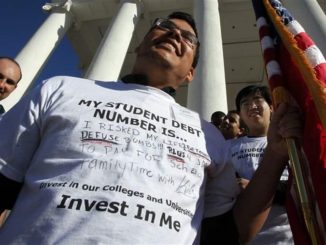
Ecosystems of local support, effective governance and innovation are key.
By Anne Wicks & William McKenzie
This is the second article in a series, The Texas Story, a special report from the George W. Bush Institute on paths to opportunity for young people in select Texas regions. Are young Texans on track for prosperous, self-determined lives? How do we know? And what might the outcomes mean for students and communities in other states? In a prior series last year, we explored these questions in Dallas, Houston and Austin. This fall, we visited two smaller Texas cities — Midland and Longview. See our earlier chapter about the challenges school districts in those two cities face in preparing students for the modern workforce. (And as always, please note: Below, we’re defining ‘governance’ as both the school board and the opportunistic use of public policy; ‘ecosystem’ as the broad coalition of organizations and community leaders focused on education and workforce outcomes across a city or region; and ‘innovation’ as the use of strong practice, sometimes new and sometimes not, with the goal of improving student outcomes.)
A community ecosystem fuels success
The ecosystems in Midland and Longview are a point of distinction. Both have traditional support from organizations like the local Chamber of Commerce, which typically understand the importance of an educated workforce to help fuel the local business community. Yet in Midland, leaders from business, philanthropy, and education are actively advocating for improvement in their school system.
The Permian Strategic Partnership, a collection of business and civic leaders and organizations, has become a catalyst in focusing the community on the trajectory of the Midland Independent School District. (Acknowledgement: Former Commerce Secretary Donald L. Evans, the Chairman of the Permian Strategic Partnership, chairs the board of the George W. Bush Presidential Center.) The PSP website acknowledges that: “The public schools in the Permian region are experiencing extreme growth and generally perform poorly compared to other areas of the state.” The site also makes clear that, “Our schools must have the resources to provide the next generation with access to highly qualified teachers and a robust curriculum.”
As happened in Dallas a decade ago, when leaders concerned about the city’s schools pushed for improvements, Midland’s education reformers are using outcome data broken apart by race, ethnicity, gender, socio-economic status and special education status to better understand where the school system is working for kids — and where it is not — to help identify solutions.
As one example, the reformers invited in the Commit Partnership, the Dallas-based collective impact organization, to help the community better understand the depth of Midland’s educational shortcomings. “Data is a tool, not a weapon,” said Midland civic leader Ronnie Scott in emphasizing the need for quality data.
Civic leaders also researched regions that exhibited educational progress, including how they use charter schools to improve student achievement. Midland ISD trustees have taken advantage of a Texas law that allows charter operators to take over failing campuses.
For its part, Midland College is working to bolster the local K-12 system. Midland’s successful Early College High School, which earned an A on the state’s 2021-2022 rankings, sits on the Midland College campus. Also, the community college now offers a four-year degree to train prospective pre-K through third grade teachers.
Scott cites the latter move as key to Midland preparing more of its own teachers. Attracting talent to communities far away from Texas’ metropolitan areas is hard. But members of Midland’s active ecosystem contributed about $30 million in private funds to create this initiative.
Community volunteers like Christine Foreman are playing a key role, too. Raised in Midland, Foreman noticed Midland’s public schools had hit rock bottom several years ago. She took action by leading Midland ISD’s 2019 bond package, which Scott, a business executive, helped craft and supported publicly.
The election drew an impressive turnout of about 23,000 voters, but went down by 26 votes. Midland’s staunch anti-tax culture contributed to the defeat, as did an insufficient number of young people turning out to approve the package.
Mobilizing enough voters in a staunchly anti-tax city to support another new bond package is a tall but important task. A city that rightly prides itself on freedom and opportunity should appreciate how much quality public schools can expand the important guiding values of the community.
Most important, Midland’s business, civic and education leaders must keep playing the role of truth-tellers. The city once had a strong set of public schools. Now, it must rebuild them. That’s not an easy message to deliver, much less hear.
Longview leaders could learn from Midland’s example. Longview ISD has a commanding leader in James Wilcox, the district’s superintendent since 2007. Through his leadership, Longview took advantage of the same state law that Midland has used to create charter schools. Except in Longview’s case, Wilcox turned the state law, SB 1882, inside out to make every one of Longview’s schools into a charter campus.
What the district needs now is a broad ecosystem, one that involves a range of organizations, leaders, and citizens in the conversation about Longview ISD’s path. Wilcox has set the vision, but widespread engagement will allow the district to build upon its progress over time — and ensure an eventual successful transition when Wilcox decides to retire.
A broad ecosystem also would help the entire 82,000-person city navigate through the maze of three school districts that serve Longview. Competitive tensions inevitably mount. A network of civic and business organizations could ensure the competition benefits the entire community.
And, as in Midland, Longview business, civic and education leaders must play the role of truth-tellers. In Longview’s case, the most recent A grade it received from the Texas Education Agency is a triumph. But it doesn’t mean that all students are having an A experience in terms of quality instruction and academic progress. The A campuses in Longview provide great opportunities to learn what interventions and approaches may better support students on lower-ranking campuses.
An innovative use of government programs
Wilcox has made International Baccalaureate curriculum and the development of Montessori schools a priority for Longview ISD. Research supports those approaches as strategies to stimulate early learning and prepare students for an education beyond high school.
The longtime superintendent is making his priority a reality through an unusual use of SB 1882. The law uses incentives to encourage districts to partner with nonprofit charters to turnaround struggling campuses. In return, the districts receive an increase in state funding for that campus.
Through Wilcox’s opportunistic use of SB 1882, all Longview ISD schools are now charter campuses. At the same time, the district is using the money from the law to finance the expansion of IB or Montessori programs, including training teachers in these models. (Not all Longview schools have one of those programs, but efforts are underway to spread them district-wide. Teachers are not currently required to be certified in IB or Montessori to be hired by the district.)
Although the three charter organizations operating in Longview have their own boards, Longview ISD essentially runs the schools since it employs the teachers and administrators in each charter. Autonomy is at the heart of charter schools, particularly autonomy around hiring, salaries, use of instructional time and curriculum. Autonomy in Longview is somewhat murky at present, particularly given the governance structure and the fact that teachers and principals are employees of the district, not the charters. Next year, when the charters come up for review, the district should run a competition to select the best charter operators, including being open to charter management operators who insist upon employing their own educators and administrators.
For its part, Midland is focused on strengthening early childhood education, teacher development, career and technical education, and long-range facility planning. Midland also has tapped into the innovations that external charter operators like Third Future Schools and IDEA Public Schools use to improve student learning.
Third Future Schools, launched by former Dallas ISD Superintendent Mike Miles, redesigned once-failing Sam Houston Collegiate Preparatory Elementary with innovations like paying higher salaries based upon a teacher’s classroom performance, assigning apprentice teachers to nurture young educators, and using a curriculum that includes a concentration in the art of thinking. Sam Houston went from a F rating in 2018-2019 to a B rating from the Texas Education Agency for the 2021-2022 school year.
In 2020, IDEA Public Schools opened the first Midland ISD charter, thanks to local foundations and leaders raising $55 million to fund the expansion of charters in Midland and Odessa. IDEA took over Travis Elementary School, a campus that the state gave a F grade in 2019. By contrast, TEA gave IDEA Travis Academy a B in 2022.
To its credit, IDEA focuses on the fundamentals of quality classroom instruction and developing effective teachers. The charter management organization notably offers a housing benefit to prospective teachers as part of its goal of developing a local pipeline of quality instructors.
As IDEA has shown with its progress in Midland, innovation need not be new. It may mean something as old-fashioned as strong instruction and a strong, welcoming culture for students.
Whether through a charter school or a traditional campus, Midland ISD will help prepare students for the world that awaits them by remaining open to innovative educational strategies.
Clear and inspired governance is key
The biggest governance challenge for Longview ISD is simplifying its unique but overlapping set of school boards. The district’s three charter operators have their own set of directors. But the charter operators eventually answer to Longview ISD’s school trustees and superintendent. Who, then, really is in charge?
Simplifying lines of authority would ensure the charters are not like a cautious driver looking back over their shoulder for approval from passengers in the backseat. Timidity leads to trouble, even danger. Longview students would be better served if the district remained the authorizing agent, while letting the charters manage their own work.
Giving quality charters freedom to operate, whether through rearranging school days, experimenting with curriculum, and using their own hiring and salary practices, has worked around the country. IDEA Public Schools, KIPP Public Schools, and YES Prep Public Schools provide three good examples.
The most important decision facing the Midland school board is hiring a superintendent to replace Angelica Ramsey, who decided in September to become Fort Worth ISD’s leader. She was hired to stabilize and advance the district after it had churned through two leaders without much progress. Ramsey was headed in the right direction by working closely with the Midland community, building the leadership capacity of principals and assistant principals, and staying on top of district data. The board would be smart to find someone with similar visionary instincts.
Midland voters elected 3 school board trustees last month. The board has made strides toward concentrating on the most important variable: student performance. In fact, Scott and others credit trustees for being intent on improving the district, focusing on such priorities as attracting talented instructors to West Texas.
Trustees also have participated in Lone Star Governance, a Texas Education Agency spinoff that focuses on effective governance. But, as in other districts, board members need to know what to do with poor results and to stay the course once they find an evidenced-backed pathway. Parochial or minor matters can dominate school board’s discussions in any district — it is easy for board agendas to be filled with matters that have the gloss of relevance but lack any substantive impact on students.
Recommendations for Texas and lessons for beyond
As we saw in our look at Texas’ big metros as well as this look at our state’s smaller cities, adult leadership matters everywhere. Smaller cities and towns are, by definition, smaller ponds. Big fish can have outsized impact, to the good or the bad. Civic engagement and service is critical in small towns, particularly for those who want their hometowns to keep their homegrown talent.
Schools that prepare young people well for real local opportunity is a strong strategy for any Texas town. We recommend that leaders in smaller cities consider these recommendations when working to improve outcomes for all young people in their towns.
Show up and engage. In a smaller city, engagement by adults really matters. Citizens need to understand the outcome data and the community context, contribute to solutions with their time and treasure and vote in school board elections. Midland’s ecosystem is pushing forward with the priorities identified before their superintendent resigned for another role. The ecosystem in Longview is less well-organized and defined.
Distribute the leadership. Transitions will happen in the central office. In smaller cities, distributing responsibility and information across district leaders ensures that improvements work and a focus on goals continues even when leadership may change
Take advantage of charters and SB 1882. As both districts show, partnering with charters through SB 1882 brought new approaches to struggling campuses — and generated revenue for the districts. District-charter partnerships provide opportunities for learning and innovation when executed with fidelity. Taking advantage of policies like SB 1882 can help smaller cities access new ideas and resources.
Use the data. There is no way around using student outcome data to measure progress. It is impossible to meaningfully improve outcomes for students without using comparable data to understand who is on track and who is lagging. Tests are not solutions in and of themselves. They are simply the tool that helps illustrate academic progress. Breaking apart that data to understand what is happening on each campus and within each subgroup of students is also important to know if all students in the district are having comparable experiences.
The Texas miracle of economic growth and opportunity is both tantalizing and sobering. Texas is the fastest-growing state in the union per the 2020 Census. People of color account for 95% of that population growth, and we need everyone in the state to have opportunity within reach for our state to thrive. We know that the progress made by Texas students through the 1990s and 2000s stalled before the pandemic — and that stall became a major crash for far too many young people thrown off track by COVID-19 disruptions to school and home.
Recovery for today’s students is not a lost cause. Texas can still cultivate and benefit from the collective ingenuity, knowledge, and leadership of our young people if adults stay the course to build and support school systems that work for all students. Adult leadership and vision matter now, more than ever.



